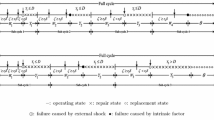Abstract
As a system failure during a mission can result in considerable penalties, at some instances it is more cost-effective to terminate operation of a system than to attempt to complete its mission. This paper analyzes the optimal mission duration for systems that operate in a random environment modeled by a Poisson shock process and can be minimally repaired during a mission. Two independent sources of failures are considered and for both cases, the failures are classified as minor or terminal in accordance with the Brown-Proschan model. Under certain assumptions, an optimal time of mission termination is obtained. It is shown that, if for some reason a termination is not technically possible at this optimal time, the mission should be terminated within a specific time interval and, if this is not possible, it should not be terminated beyond this interval. Illustrative examples are presented. The influence of mission and system parameters on the mission termination interval is demonstrated.
Similar content being viewed by others
Abbreviations
- HPP:
-
homogeneous Poisson process
- NHPP:
-
non-homogeneous Poisson process
- MSP:
-
mission success probability
- Cdf:
-
cumulative distribution function
- T :
-
mission completion time
- τ :
-
time of premature mission termination
- λ(t):
-
failure rate with respect to internal failures
- λ c (t):
-
failure rate for the combined model
- λ m f (t):
-
failure rate with respect to major internal failure
- p int(t):
-
probability that the internal failure is major
- q i n t (t):
-
probability that internal failure is minor
- S i n t (t):
-
survival function with respect to the major internal failure
- S s h (t):
-
survival function with respect to major failure caused by shocks
- S c (t):
-
survival function for the combined model
- v(t):
-
rate of the NHPP of shocks
- r m (t):
-
rate of the NHPP of minimal repairs in the combined model
- R m (t):
-
cumulative rate of the NHPP of minimal repairs in the combined model
- p s h (t):
-
probability that a shock results in a major failure
- q s h (t):
-
probability that a shock results in a minor failure
- \(q_{sh}^{0} (t)\) :
-
probability that a shock is harmless
- C(T):
-
profit associated with completion of a mission
- C R :
-
reward for completing a mission
- c p :
-
per time unit profit for the failure-free performance (cost of product supplied in time unit)
- c o :
-
per time unit operational cost
- c m :
-
cost of a single minimal repair
- C f :
-
penalty associated with system failure
- C t e r :
-
penalty associated with premature mission termination
- A(τ):
-
profit comparison function
- R τ :
-
number of minimal repairs performed by time τ from the mission beginning
References
Aven T, Jensen U (1999) Stochastic models in reliability. Springer-Verlag, New York
Block HW, Borges W, Savits TH (1985) Age-dependent minimal repair. J Appl Probab 22:370–386
Boland PJ (1982). Periodic replacement when minimal repair costs vary with time, Nav Res Logist, 29: 541–546
Brown M, Proschan F (1983) Imperfect repair. J Appl Probab 20(4):851–859
Caballé NC, Castro IT, Pérez CJ, Lanza-Gutiérrez JM (2015) A condition-based maintenance of a dependent degradation-threshold-shock model in a system with multiple degradation processes. Reliab Eng Syst Saf 134:98–109
Cha JH, Finkelstein M (2011) On new classes of extreme shock models and some generalizations. J Appl Probab 48:258–270
Finkelstein M (2008) Failure rate modelling for reliability and risk. Springer, London
Finkelstein M (2007) Shocks in homogeneous and heterogeneous populations. Reliab Eng Syst Saf 92:569–575
Finkelstein M, Cha JH (2013) Stochastic modelling for reliability. Shocks, Burn-in and Heterogeneous Populations. Springer, London
Finkelstein M, Marais F (2010) On Terminating Poisson processes in some shock models. Reliab Eng Syst Saf 95:874–879
Jiang L, Feng Q, Coit D (2015) Modeling zoned shock effects on stochastic degradation in dependent failure processes. IIE Trans 47:460–470
Kenzin M, Frostig E (2009) M out of n inspected systems subject to shocks in random environment. Reliab Eng Syst Saf 94:1322–1330
Levitin G, Xing L, Dai Y (2017) Mission abort policy in heterogeneous non-repairable 1-out-of-N warm standby systems, to appear in IEEE Transactions on Reliability
Montoro-Cazorla D, Pérez-Ocón R, del Carmen Segovia M (2009) Replacement policy in a system under shocks following a Markovian arrival process. Reliab Eng Syst Saf 94:497–502
Myers A (2009) Probability of loss assessment of critical k-Out-of-n: G systems having a mission abort policy. IEEE Trans Reliab 58(4):694–701
Noorossana R, Sabri-Laghaie K (2015) Reliability and maintenance models for a dependent competing-risk system with multiple time-scales. Proc Institution Mech Eng Part O-J Risk Reliab 229:131–142
Ruiz-Castro JE (2014) Preventive maintenance of a multi-state device subject to internal failure and damage due to external shocks. IEEE Trans Reliab 63:646–660
Song S, Coit D, Feng Q (2014) Reliability for systems of degrading components with distinct component shock sets. Reliab Eng Syst Saf 132:115–124
van der Weide JAM, Pandey MD (2011) Stochastic analysis of shock process and modeling of condition-based maintenance. Reliab Eng Syst Saf 96:619–626
Acknowledgments
The authors want to thank the Editor and the referees for helpful comments and constructive suggestions.
Author information
Authors and Affiliations
Corresponding author
Rights and permissions
About this article
Cite this article
Finkelstein, M., Levitin, G. Optimal Mission Duration for Partially Repairable Systems Operating in a Random Environment. Methodol Comput Appl Probab 20, 505–516 (2018). https://doi.org/10.1007/s11009-017-9571-6
Received:
Revised:
Accepted:
Published:
Issue Date:
DOI: https://doi.org/10.1007/s11009-017-9571-6




